
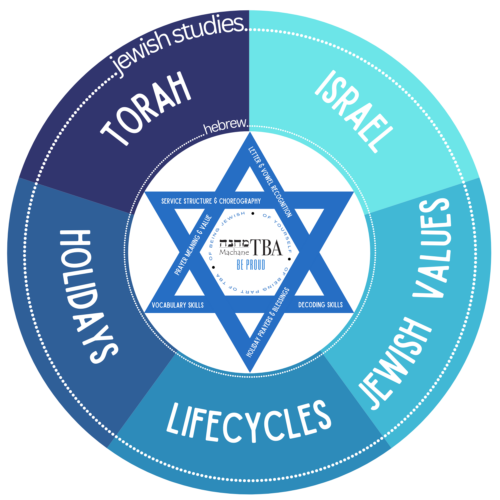
Our PreK - 6th Grade Jewish Studies and Hebrew Curriculum is instructed in a spiral where topics repeat, develop, connect and expand in depth across multiple years of study.



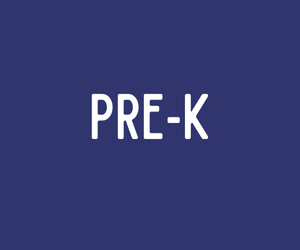
- Enhance their knowledge of what the Bible is and why the stories in it are important
- Explore in depth the Noah’s Ark story as well as the Passover story
- Engage in large scale hands on group programming to reinforce the story through a play based strategy
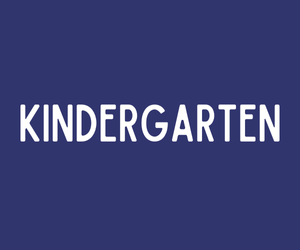
- Enhance their knowledge of what the Bible is and why the stories in it are important
- Read and learn about Jonah and the Big Fish and Jacob’s Ladder
- Connect Jewish values to the above stories
- Engage in large scale hands on group programming to reinforce the stories through a play based means
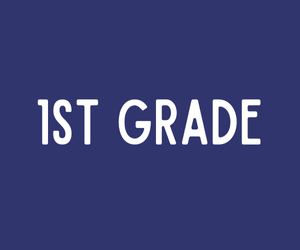
- Students will read Bible stories such as: Creation, Adam & Eve, Noah, Tower of Babel, Abraham & Sarah, Isaac & Rebecca, Jacob & Esau, Joseph & His Brothers, Moses.
- Make personal and real world connections with the stories and Jewish values in the Bible stories.
- Engage in hands on large group programming to explore Bible stories through a play based technique
- Engage in art activities that correlate to key concepts in the Bible stories
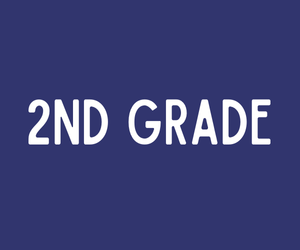
- Students will learn Bible stories building on the Alef (first grade) curriculum
- Engage in large scale interactive hands-on programming to better understand morals and themes of the Bible stories.
- Students will associate jewish values with appropriate Bible stories.
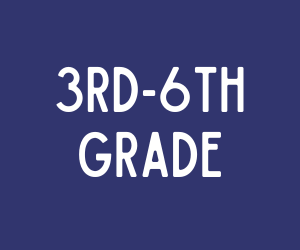
- Understand the concept of our Torah as a major part of the Jewish religion
- Discuss the Themes of each book of the Torah, including learning of the main characters (Adam, Eve, Abraham Isaac Jacob, Sarah, Rebekka, Leah, Rachel, Joseph, Moses etc.)
- Engage in relevant related activities such as creating crafts from the stories or recreating them in a class play.
- Analyze the relevance of these stories to contemporary ethical and moral issues

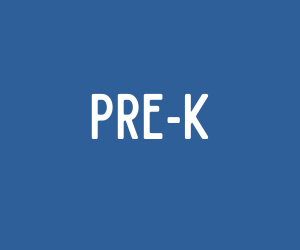
- Learn about the major festivals in the Jewish calendar year: Rosh Hashanah, Yom Kippur, Sukkot, Simchat Torah, Chanukah, Purim, Passover, Shavuot, Shabbat
- Study holidays through their senses exploring what they see, hear, feel, smell, and taste during each holiday
- Create ritual objects to take home and utilize during holiday celebrations

- Learn about Rosh Hashanah, Yom Kippur, Sukkot, Simchat Torah, Hanukkah, Tu B’Shevat, Purim, Passover, Yom Ha’Atzma’ut, Shavuot and Shabbat.
- Engage in hands-on activities including craft projects, games, puzzles and role-playing to learn about the holidays.
- Sample foods associated with the various holidays, including weekly juice and challah for Shabbat.*
- Practice the Shabbat blessings with their weekly snack of juice and challah.
- Learn that Shabbat is a holy time that is separate from the rest of the week.
- Design and create ritual objects to use at home.
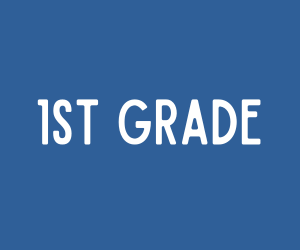
- Students will learn about the major festivals in the Jewish calendar year: Rosh Hashanah, Yom Kippur, Sukkot, Simchat Torah, Chanukah, Purim, Passover, Shavuot, Shabbat
- Students will learn songs and read stories about the festivals.
- Students will identify symbols, foods and vocabulary related to the festivals and Shabbat.
- Students hear and repeat prayers related to the festivals.
- Students will learn objects associated with celebrating Shabbat and practice the Shabbat blessings.
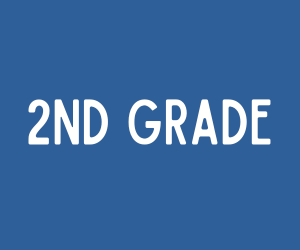
- Students will be able to identify the major Jewish holidays: Rosh Hashanah, Yom Kippur, Sukkot, Simchat Torah, Chanukah, Tu B’Shevat, Purim, Passover, Yom Ha’atzmaut, and Shavuot..
- Students will learn about their historical significance and modern practices associated with each.
- They will identify symbols, foods, and vocabulary related to the festivals and Shabbat.
- Students will associate Shabbat with the Biblical story of Creation and resting in their daily lives and compare Shabbat with an ordinary day of the week.
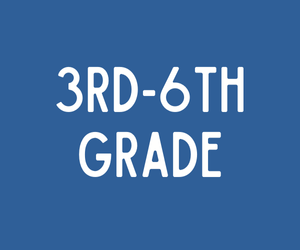
- Learn the basic significance of Shabbat, Rosh Hashanah, Yom Kippur, Sukkot, Hanukkah,Tu B’Shevat, Purim, Passover, Shavuot, and Simchat Torah
- Identify and describe key symbols and traditions associated with each holiday (e.g., shofar, Lulav, matzah)
- Participate in simple holiday-related crafts and activities (e.g., making a Sukkah decoration, spinning dreidels)
- Listen and say together short blessings as a class associated with each holiday (e.g., lighting Shabbat candles, blessing over the wine)

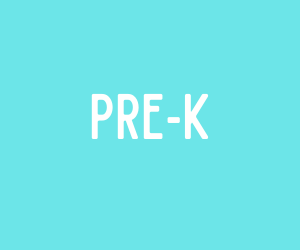
- Enhance their understanding of the concept of a country
- Compare and contrast Israel to America
- Learn about Israeli culture including music, dancing, and sports
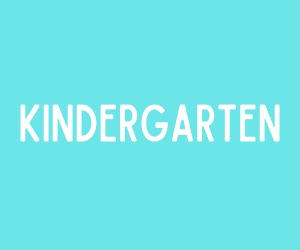
- Enhance their understanding of the concept of a country and increase their knowledge on the location of Israel
- Develop a knowledge of the connection between Judaism and Israel
- Learn about Israeli culture including music, dancing, and sports
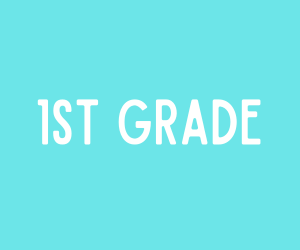
- Celebrate Israeli Independence day and increase their connection to the country
- Engage in a letter writing program to Israeli soldiers
- Learn about Israeli culture including music, dancing,and sports
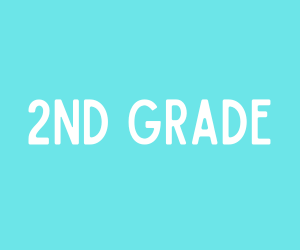
- Celebrate Israeli independence day and increase their connection to the country
- Learn about Israeli culture including music, dancing, and sports
- Make connections between Israel and the hebrew language
- Learn about Israeli landmarks

- Study the history of modern Israel, including key events and figures (e.g., founding of the state, important leaders).
- Learn about Israeli culture, including music, food, and traditions
- Discuss the significance of Israel to Jewish identity and heritage
- Create projects that explore different aspects of Israeli society (e.g., Israeli innovations, or a city or region).
- Participate and lead an Israel themed-day activities
- Explore Israel’s contributions to technology, science, and the arts
- Discuss the relationship between Israel and the global Jewish diaspora

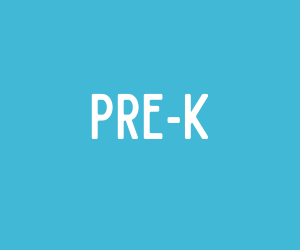
- Students will begin to define what a value is
- Students will learn about the Jewish values of kindness, sharing, family, family traditions, and friendship through hand on activities and stories
- Students will participate in a social action project to practice the value of sharing.
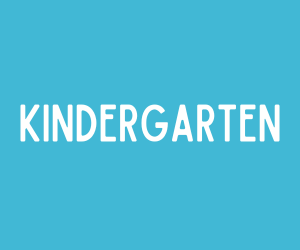
- Students will gain an understanding of the concept and importance of Jewish values.
- Students will learn about the following Jewish values through stories, discussions and activities: Chesed (kindness), Reut (friendship), Mitzvot (commandments/good deeds), Tzedakah (righteous giving), Kibud Zekaynim (Honoring elders) and Tzaar Ba’alei Chayim (kindness to animals).
- They will engage in discussions and activities reinforcing how these values positively influence their lives and the people around them.
- Students will participate in a social action project to practice the value of chesed

- Students will learn about Jewish values through age appropriate stories: Kavode (respect), Chesed (kindness), Mitzvot (commandments/good deeds), Tzedakah (righteous giving), Adam Yehidi Nivrah (respecting differences)
- They will engage in discussions and activities reinforcing how these values positively influence their lives and the people around them.
- Students will participate in social action project to practice the value of mitzvot

- Students will learn about the following Jewish values from age appropriate bible stories and storybooks: Mitzvot (commandments/good deeds), Chesed (showing kindness), Kavode (respect), Tikkun Olam (repairing the world), Emet (honesty), Tzedakah (righteous giving), Adam Yehidi Nivrah (respecting differences), Hoda’ah (gratitude), Teshuva (forgiveness).
- They will engage in discussions and activities reinforcing how these values positively influence their lives and the people around them.
- Students will participate in a social action project to practice the value of Tikkun olam

- Students will learn about key Jewish values such as Kindness (chesed), Respect (kavod), Tzedakah (charity) and Community (kehillah).
- Students will explore how these values are applied in various situations, both in Jewish tradition and in their own lives.
- Students will connect major values to themselves and the world by looking at values such as B’tzelem Elohim (We are createdIn the image of G-d), Ve-Ahavta L’Re-ekha K’Mokha (Love your Neighbor as you Love Yourself), Bikkur Cholim (Visiting the Sick) and more.
- Students will identify and discuss examples of Jewish values in action through stories, role-playing, games, and real-life scenarios.
- Students will reflect on how they can incorporate Jewish values into their daily behavior at home, in school and in their community.
- Students will engage in activities that allow them to practice these values such as Social Action projects, collaborative classroom initiatives, art projects and more.

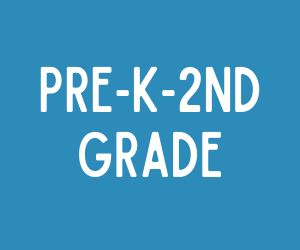
- Students will tour the synagogue with one of our Rabbis and learn that it is a place to pray, learn and meet with friends
- Students will identify ritual objects in the sanctuary
- Students will explore the Jewish calendar and ritual cycle
- Students will learn about the concept of a Hebrew name and how Hebrew names are chosen
- In depth study of lifecycle rites and rituals begins in 3rd grade
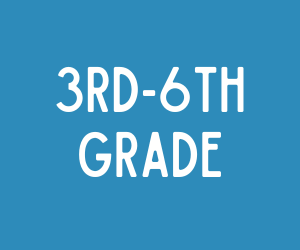
- Students will learn to identify and name major Jewish lifecycle events such as birth (bris and baby naming), Bar/Bat Mitzvah, Marriage and Death.
- Students will explore the meaning and importance of each lifecycle event within the context of Jewish tradition and community.
- Students will learn to recognize and describe the rituals and symbols associated with each lifecycle event, such as breaking of the glass at a wedding or the tallit worn during a bar/bat mitzvah.
- Students will reflect on their own lives and consider how these lifecycle events relate to their personal experiences or what they’ve observed in their communities and compare and contrast lived experiences with their peers, teachers and clergy.
- Students will express their understandings of Jewish lifecycle events through art, or other creative projects that illustrate the meaning and traditions of these events.

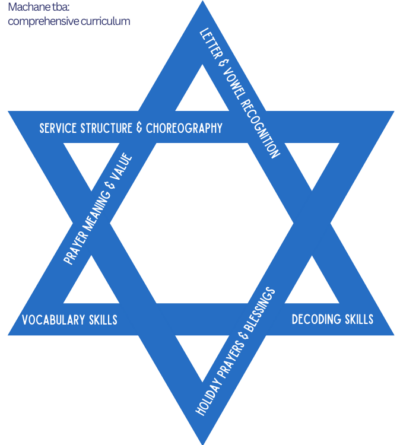
Hebrew Curriculum - Primary Pre-K to 2nd Grade
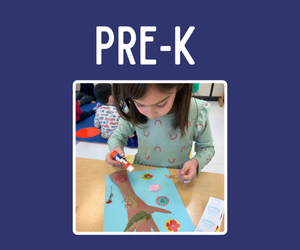
GOAL – Students will be introduced to the concept of the Alef-Bet (Hebrew alphabet) order. Students will learn beginner conversational Hebrew vocabulary including weather vocabulary and articles of clothing. Shabbat and holiday blessings will be practiced.
METHOD – Students will use hands on and tactile learning tools as well as music to recognize the order of the Aleph-Bet. Students will use play based language immersion tools to learn appropriate vocab. Students will have T’filah (prayer) and Shira (music).
OUTCOME – Students will recognize the order of the Alef-Bet and have a basic understanding of beginner hebrew conversational vocabulary.
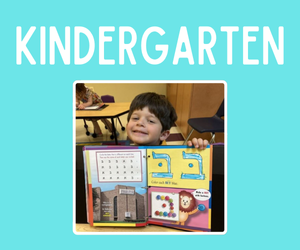
GOAL – Students will learn the order of the Alef-Bet (Hebrew alphabet) along with Hebrew letter recognition and beginner phonics. Students will be able to recognize Hebrew numbers 1 through 10 and Hebrew names for people in their family. Shabbat and holiday blessings will be practiced.
METHOD – Students will learn through a combination of hands-on tactile learning and the Let’s Discover the Alef Bet series through Berman House. Students will have T’filah (prayer) and Shira (music).
OUTCOME – Students are able to recognize order of the Alef-Bet as well as phonetics of each letter.
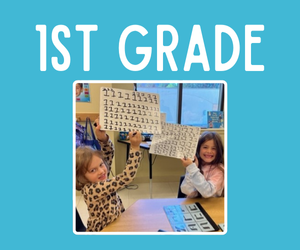
GOAL – Students will review Hebrew letter recognition and phonics and will add vowel sound awareness. Conversational Hebrew vocabulary will include colors and parts of the body. Shabbat and holiday blessings will be practiced.
METHOD – Students will use a game-based hands-on learning strategy to reach these goals. Students will have T’filah (prayer) and Shira (music).
OUTCOME – Students will be able to connect Hebrew letters to vowel sounds to change the phonics of the sound.

GOAL – Students will review Hebrew phonics and vowel sound awareness. Students will begin to differentiate differences between reading in Hebrew and English. Students will develop beginner decoding skills and start to combine two to three hebrew sounds together with vowels. Students will increase their conversational Hebrew by learning the days of the week and the objects/people in a classroom in Hebrew. Shabbat and holiday blessings will be practiced.
METHOD – Students will use a game-based hands-on learning strategy to reach these goals. Students will have T’filah (prayer) and Shira (music).
OUTCOME – Students will begin to combine multiple letter sounds with vowels.
Hebrew Curriculum - L'mala/L'mata Grades 3-6
Our L’mala (upstairs) classroom-based and L’mata (downstairs) experiential-based programs are designed to complement and supplement each other to meet educational objectives through a multidisciplinary approach.
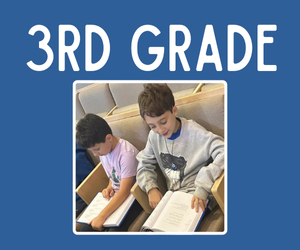
L’MALA (Upstairs) Classroom-Based Educational Block:
GOAL – Students should be able to decode Hebrew words accurately and with some fluency. Introduction to reading with vowels and understanding of key Hebrew words. Shabbat and Holiday blessings will be practiced.
METHOD – Using the Zeman Likro (Time to Read Hebrew) program we will teach easy and common letters and vowel sounds first, look alike letters are taught separately, more complex sounds are taught later on. Each unit has a variety of materials and components of reinforcement. Each lesson culminates with a 10 word evaluation.
OUTCOME – Students will be able to read and understand all Hebrew letter and vowel sounds.
L’MATA (Downstairs) Experiential Educational Block:
GOAL – Service choreography, service structure, prayer meaning, prayer fluency, prayer melodies, contemporary Jewish music.
METHOD – Weekly t’filah (prayer service) with inclusion of Friday evening and Saturday morning prayers, weekly repetition of prayer structure, weekly inclusion of and conversations around prayer meaning, exposure to a variety of different melodies for each prayer, inclusion of holiday music, individual grade leading portion of the t’filah to practice and promote prayer fluency
OUTCOME – Exposure to prayers of the Friday evening and Saturday morning services. Students learn the mechanics of chanting and understanding the prayers, and also engage on a thematic and personal level. Using traditional text, we inspire and celebrate individuality and promote being part of and connecting to a supportive community.
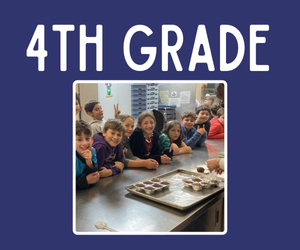
L’MALA (Upstairs) Classroom-Based Educational Block
GOAL – Students should be able to read/recite prayers that are connected to Jewish home rituals such as the Shema, Shabbat and holiday blessings.
METHOD – Using the Kol Yisrael series of textbooks, 4th grade begins with level 1. Using kid friendly language to explore the meaning of and reasons behind prayer-so students understand the words they are saying and why we pray. Through repetition of reading, games,and flashcards this series can appeal to different learning styles.
OUTCOME – Students will understand the difference between an everyday blessing versus a blessing that is also a commandment or mitzvah.
L’MATA (Downstairs) Experiential Educational Block:
GOAL – Service choreography, service structure, prayer meaning, prayer fluency, prayer melodies, contemporary Jewish music
METHOD – Weekly t’filah (prayer service) with inclusion of Friday evening and Saturday morning prayers, weekly repetition of prayer structure, weekly inclusion of and conversations around prayer meaning, exposure to a variety of different melodies for each prayer, inclusion of holiday music, individual grade leading portion of the t’filah to practice and promote prayer fluency
OUTCOME – Exposure to prayers of the Friday evening and Saturday morning services. Students learn the mechanics of chanting and understanding the prayers, and also engage on a thematic and personal level. Using traditional text, we inspire and celebrate individuality and promote being part of and connecting to a supportive community.
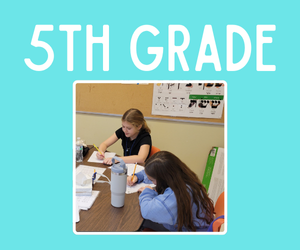
L’MALA (Upstairs) Classroom-Based Educational Block:
GOAL – Students should be able to recite prayers associated with a Friday evening Shabbat service
METHOD – Using our siddur (Mishkan Tefilah) and the Kol Yisrael series of textbooks, 5th grade begins with level 2. Using kid friendly language to explore the meaning of and reasons behind prayer-so students understand the words they are saying and why we pray. Through repetition of reading, games and flashcards, this series can appeal to different learning styles. Complimentary online tutoring is available for 5th grade students for additional support. Friday night Shabbat service prayers are available online for students to practice (Contact Lisa Goodman for password).
OUTCOME – Students will understand the structure of and be able to help lead the congregation in a Friday evening Shabbat service
L’MATA (Downstairs) Experiential Educational Block:
GOAL – Service choreography, service structure, prayer meaning, prayer fluency, prayer melodies, contemporary Jewish music.
METHOD – Weekly t’filah (prayer service) with inclusion of Friday evening and Saturday morning prayers, weekly repetition of prayer structure, weekly inclusion of and conversations around prayer meaning, exposure to a variety of different melodies for each prayer, inclusion of holiday music, individual grade leading portion of the t’filah to practice and promote prayer fluency
OUTCOME – Exposure to prayers of the Friday evening and Saturday morning services. Students learn the mechanics of chanting and understanding the prayers, and also engage on a thematic and personal level. Using traditional text, we inspire and celebrate individuality and promote being part of and connecting to a supportive community.
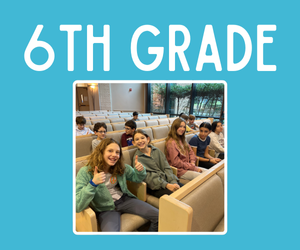
L’MALA (Upstairs) Classroom-Based Educational Block:
GOAL – Fluent prayer reading with comprehension and familiarity of a Torah service.
METHOD – Using our siddur (Mishkan Tefilah) and the Kol Yisrael series of textbooks, 6th grade advances to Level 3, through seven units that teach the meaning of each prayer, its background, and how it helps us live according to Jewish values. These prayers are also taught as a bridge to our B’nei Mitzvah course of study. Complimentary online tutoring is available for 6th grade students for additional support. Friday night Torah service prayers are available online for students to practice (Contact Lisa Goodman for password).
OUTCOME – Students will understand the structure of and help lead the congregation in a Shabbat/Torah service.
L’MATA (Downstairs) Experiential Educational Block:
GOAL – Service choreography, service structure, prayer meaning, prayer fluency, prayer melodies, contemporary Jewish music
METHOD – Weekly t’filah (prayer service) with inclusion of Friday evening and Saturday morning prayers, weekly repetition of prayer structure, weekly inclusion of and conversations around prayer meaning, exposure to a variety of different melodies for each prayer, inclusion of holiday music, individual grade leading portion of the t’filah to practice and promote prayer fluency
OUTCOME – Exposure to prayers of the Friday evening and Saturday morning services. Students learn the mechanics of chanting and understanding the prayers, and also engage on a thematic and personal level. Using traditional text, we inspire and celebrate individuality and promote being part of and connecting to a supportive community.
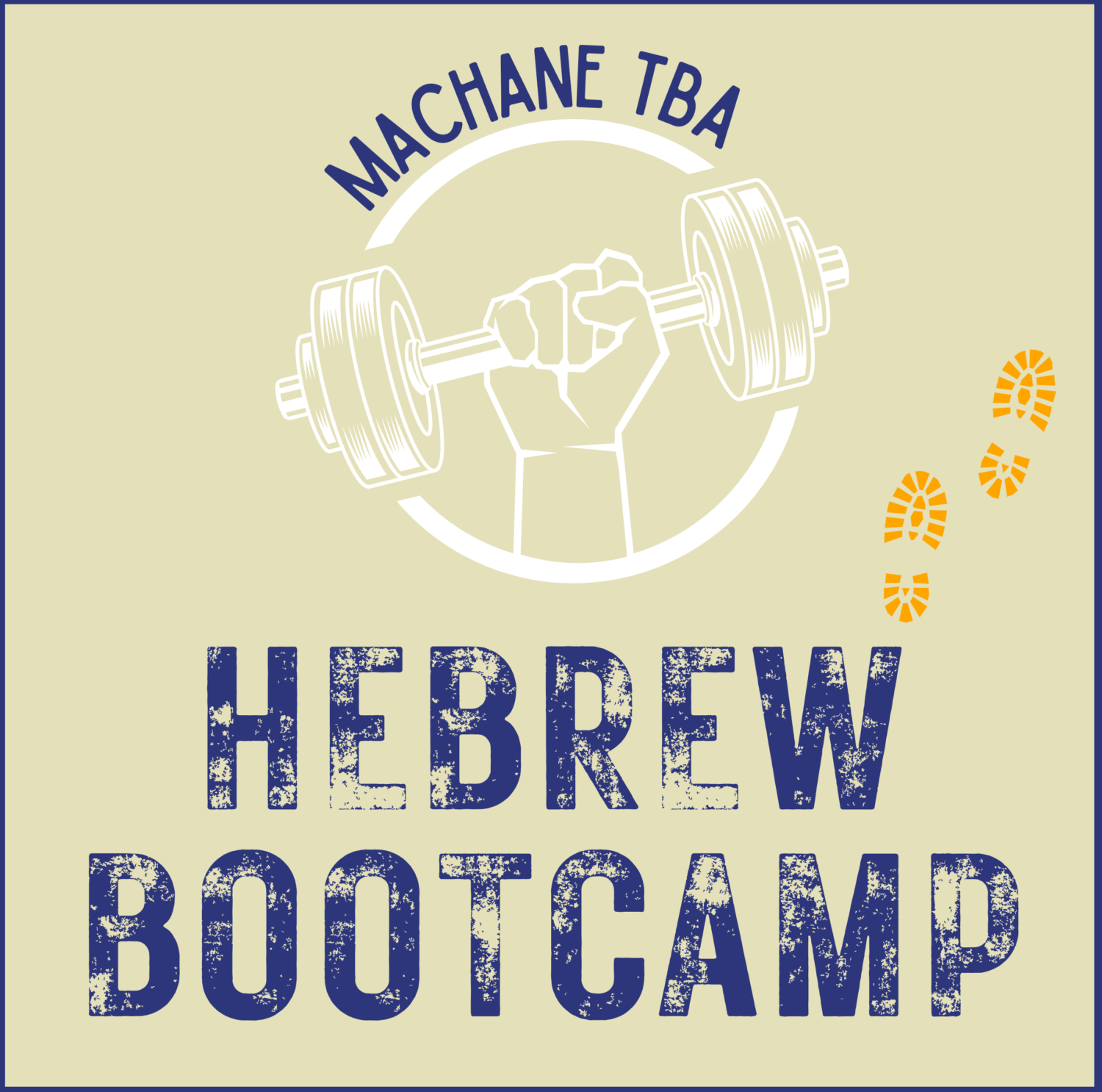
HEBREW BOOTCAMP
To enhance Hebrew learning each year after winter break, we hold our annual 6-week Hebrew Bootcamp for all 3rd through 6th grade students.
The Bootcamp is held weekly during the L’mala (upstairs) classroom-based educational block. Students spend an increased amount of time focused on Hebrew with an emphasis on letter and prayer literacy.
If you have any questions, please contact your child’s L’mata teacher or Lisa Goodman, L’mata Supervisor.

